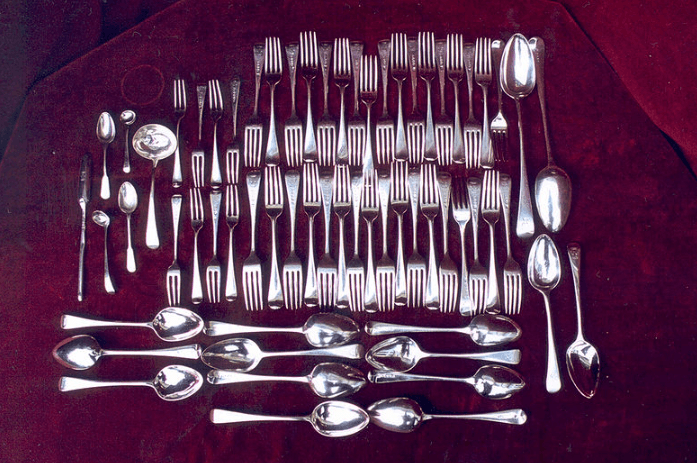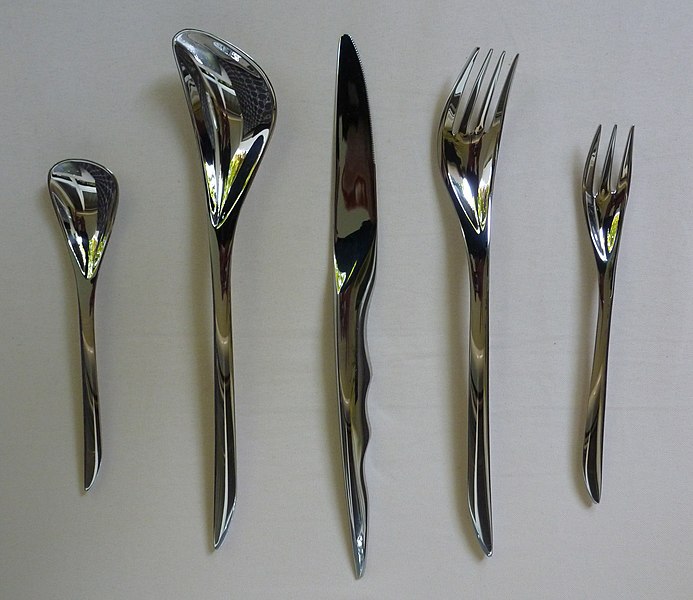What Is the Difference Between 18/0 and 18/10 Cookware?
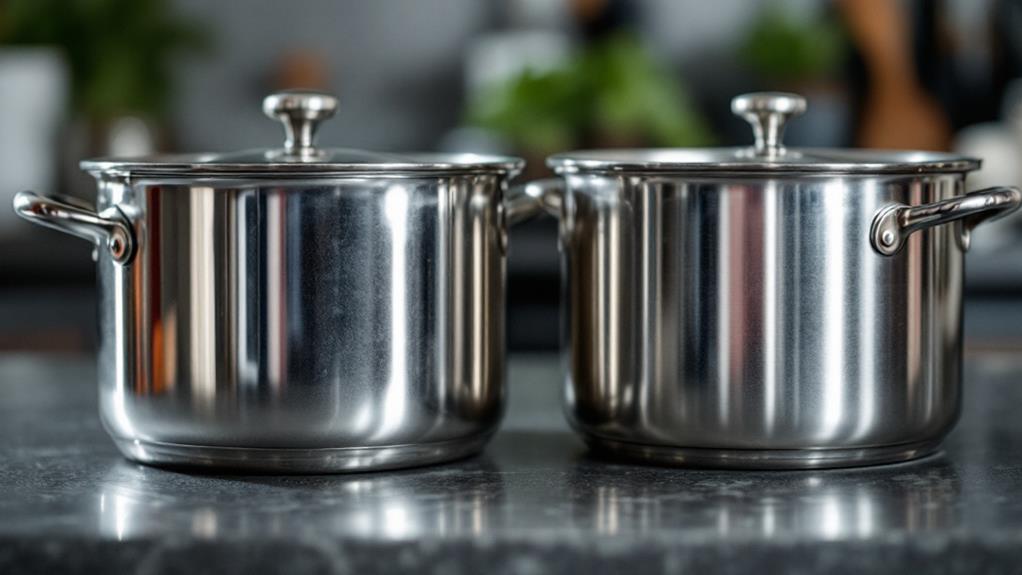
The main difference between 18/0 and 18/10 cookware lies in their nickel content. 18/10 stainless steel contains 10% nickel, while 18/0 has none. This impacts durability, appearance, and performance. 18/10 cookware is more resistant to corrosion, has a shinier finish, and distributes heat more evenly. It's also typically more costly. 18/0 cookware is more affordable but may stain or discolor more readily. Both are safe for food contact and require proper maintenance. Your choice depends on your budget, cooking needs, and aesthetic preferences.
There's more to evaluate when selecting the perfect cookware for your kitchen.
Composition of Stainless Steel Cookware
Stainless steel's composition plays an essential role in determining cookware quality and performance. When you're shopping for stainless steel cookware, you'll often come across two main types: 18/0 and 18/10. These numbers refer to the percentages of chromium and nickel in the steel alloy.
18/0 stainless steel contains 18% chromium but no nickel. This composition makes it more affordable, but it comes with some drawbacks. Without nickel, 18/0 cookware is more susceptible to corrosion, staining, and discoloration. It's also less durable and doesn't distribute heat as effectively as its counterpart.
On the other hand, 18/10 stainless steel contains 18% chromium and 10% nickel. This higher nickel content considerably improves the steel's properties. You'll find that 18/10 cookware offers superior corrosion resistance, making it less likely to rust or stain. It also boasts a brighter, more lustrous finish that maintains its appearance over time. The added nickel enhances durability and heat distribution, resulting in better cooking performance.
While 18/10 stainless steel cookware comes at a higher price point, its improved quality and longevity often make it a worthwhile investment for serious home cooks and professionals alike.
Nickel Content and Its Effects
The nickel factor plays an essential role in distinguishing 18/10 from 18/0 stainless steel cookware. The main difference lies in their nickel content: 18/10 contains 10% nickel, while 18/0 has none. This variation considerably impacts the performance and durability of your cookware.
When you choose 18/10 stainless steel, you're opting for superior corrosion resistance. The combination of chromium and nickel creates a more durable protective layer, making your cookware less prone to staining, rusting, and discoloration over time. You'll also notice that 18/10 cookware maintains a brighter shine and better withstands high temperatures.
On the other hand, 18/0 stainless steel lacks nickel, making it more susceptible to wear and tear. Without the added strength and durability that nickel provides, your 18/0 cookware may not hold up as well in the long run. However, it is crucial to note that 18/0 cookware is generally more budget-friendly due to its lower nickel content.
Ultimately, the choice between 18/10 and 18/0 cookware depends on your priorities. If you value longevity and performance, 18/10 is the way to go. If cost is a primary concern, 18/0 might be a suitable alternative.
Durability and Corrosion Resistance

Diving into durability and corrosion resistance, you'll find that 18/10 stainless steel cookware vastly outperforms its 18/0 counterpart. The key difference lies in the nickel content, with 18/10 containing 10% nickel compared to 18/0's lack of this pivotal element. This higher nickel content, combined with increased chromium, gives 18/10 stainless steel superior corrosion resistance and durability.
You'll notice that 18/10 cookware is less susceptible to pitting, rusting, and discoloration over time. It's more forgiving when it comes to wear and tear, extending the lifespan of your pots and pans. In contrast, 18/0 stainless steel is more prone to corrosion and staining due to its lack of nickel.
While proper care and cleaning are important for both types of cookware, 18/10 stainless steel is generally more forgiving. You'll find it easier to maintain its appearance and functionality over time. If you're looking for cookware that can withstand the rigors of daily use and retain its luster, 18/10 stainless steel is the clear winner. Its superior durability and corrosion resistance make it a worthwhile investment for your kitchen.
Appearance and Shine
When it comes to appearance and shine, you'll notice a striking difference between 18/10 and 18/0 stainless steel cookware. 18/10 cookware boasts a brilliant, lustrous finish that catches the eye and adds a touch of elegance to your kitchen. This superior shine is primarily due to the higher nickel content in 18/10 stainless steel.
The nickel and chromium composition of 18/10 stainless steel contributes to its premium appearance, setting it apart from the duller look of 18/0 cookware. The latter lacks nickel, resulting in a less polished appearance that may not be as visually appealing.
Manufacturers of 18/10 cookware employ a scrupulous buffing process to create a refined, mirror-like finish. This extra step enhances the natural luster of the material, making it stand out in your kitchen.
To maintain the glossy shine of your 18/10 stainless steel cookware, you'll need to care for it properly. Regular polishing and appropriate cleaning methods will help preserve its lustrous appearance over time. With the right maintenance, your 18/10 cookware will continue to impress with its brilliant shine for years to come.
Heat Distribution Properties
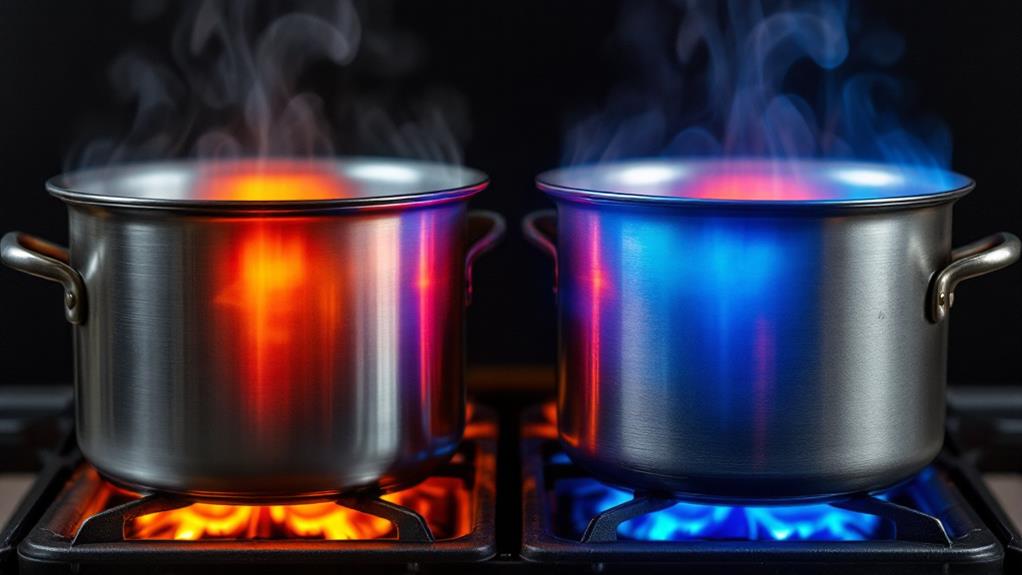
You'll notice a significant difference in heat distribution when comparing 18/10 and 18/0 stainless steel cookware. The higher nickel content in 18/10 stainless steel gives it superior heat distribution properties. This means that when you're cooking with 18/10 cookware, heat is spread more evenly across the surface, leading to more consistent results in your dishes.
The improved thermal properties of 18/10 stainless steel make it an excellent choice for recipes that require precise temperature control. You'll find that food cooks more uniformly, reducing the risk of hot spots that can cause burning or uneven cooking. Additionally, 18/10 cookware retains heat better, which can be beneficial when you're trying to keep food warm or when you need to maintain a steady temperature during cooking.
While 18/0 stainless steel is still a decent conductor of heat, it doesn't match the performance of its 18/10 counterpart. If you're serious about your cooking and want the best possible heat distribution, 18/10 stainless steel cookware is the way to go. You'll appreciate the enhanced control and consistency it offers in your culinary pursuits.
Cost and Affordability
On the cost range of stainless steel cookware, 18/0 sits at the more affordable end, while 18/10 commands a higher price point. If you're shopping on a budget, you'll find that 18/0 stainless steel options are generally less expensive, making them an attractive choice for cost-conscious consumers.
The price difference between these two types of cookware is primarily due to their nickel content. 18/10 stainless steel contains more nickel, which contributes to its elevated cost. However, this increased nickel content also offers benefits regarding durability and corrosion resistance.
When choosing between 18/0 and 18/10 stainless steel cookware, you'll need to weigh quality against affordability. If you're looking for a middle ground, consider 18/8 stainless steel, which typically falls between 18/0 and 18/10 in the context of price.
Ultimately, your decision will depend on your budget and personal preferences. If you're willing to invest more for higher quality, 18/10 might be the way to go. However, if you're looking for a more economical option that still offers decent performance, 18/0 stainless steel cookware could be a suitable choice.
Recommended Uses
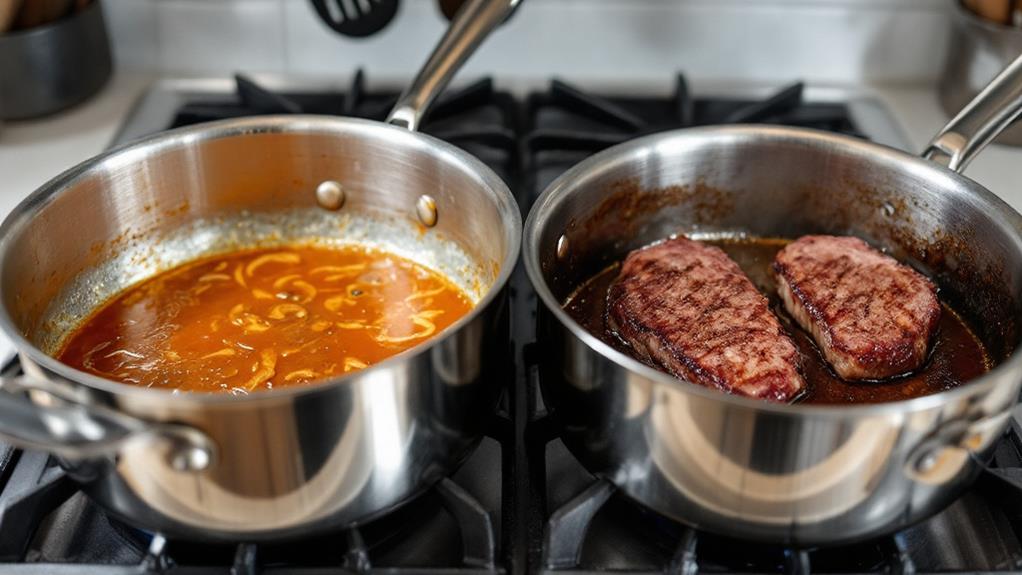
Versatility shines through when considering the recommended uses for different types of stainless steel cookware. 18/10 stainless steel stands out as the top choice for both everyday cooking and formal dining situations. This type of stainless steel contains the highest percentage of chromium and nickel, offering superior corrosion resistance and a lustrous finish that's perfect for impressing guests at dinner parties.
If you're looking for a balance between quality and affordability, 18/8 stainless steel is an excellent option. It's well-suited for everyday use and can still hold its own at occasional gatherings. The corrosion resistance is still impressive, making it a reliable choice for your kitchen.
For basic, everyday cooking needs, 18/0 stainless steel can be used effectively. However, keep in mind that it's more prone to pitting and discoloration over time. You might want to reserve your 18/10 or 18/8 cookware for special occasions or when presentation matters.
When choosing your cookware, consider how you'll be using it most often. If you frequently host dinner parties or value premium performance, investing in 18/10 or 18/8 stainless steel will serve you well. For simpler cooking needs, 18/0 can suffice.
Health and Safety Considerations
When considering stainless steel cookware, health and safety are paramount concerns for many home cooks. You'll be pleased to know that both 18/0 and 18/10 stainless steel grades are approved for food contact and pose minimal health risks when properly maintained.
The main difference between these grades lies in their composition. 18/10 stainless steel contains 18% chromium and 8% nickel, making it more resistant to corrosion than 18/0, which lacks nickel. However, this difference doesn't greatly impact safety. The nickel content in 18/10 cookware poses negligible health hazards, as leaching is generally not a concern with well-maintained stainless steel.
To guarantee the safety of your cookware, focus on proper care and cleaning rather than worrying about the specific grade. Both 18/0 and 18/10 stainless steel are highly resistant to rust and corrosion when maintained correctly. Regular cleaning and avoiding harsh abrasives will help prevent any potential contamination issues.
When choosing between 18/0 and 18/10 cookware, consider factors like durability, corrosion resistance, and aesthetics rather than health concerns. Both grades are safe for cooking when used properly, so select the option that best suits your needs and preferences.
Maintenance and Care
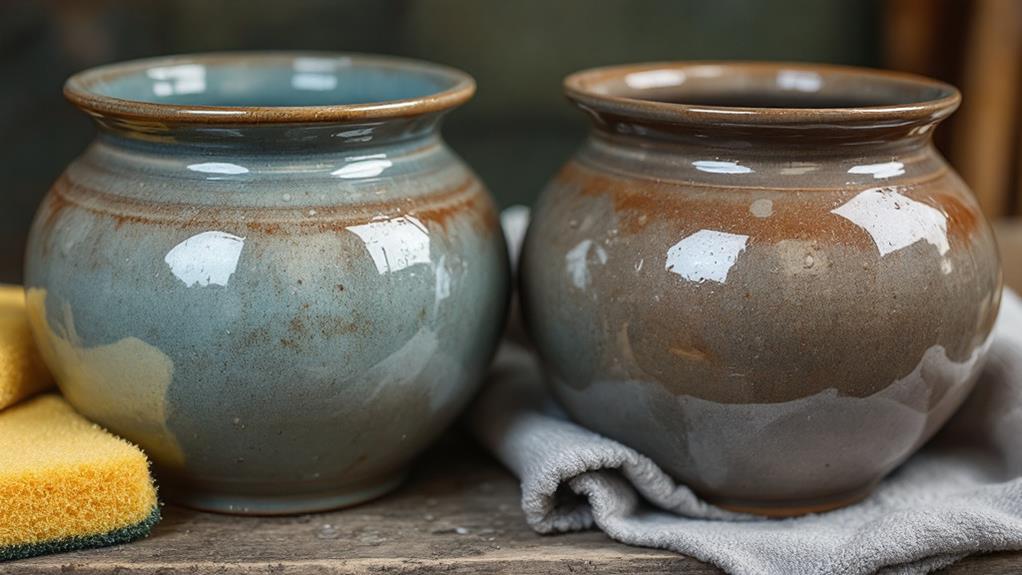
While both 18/0 and 18/10 stainless steel cookware are durable, proper maintenance is key to preserving their quality and longevity. Regular cleaning and drying are pivotal for maintaining their appearance and preventing corrosion. Hand washing is generally recommended for both types to preserve the finish and prevent water spots, though 18/10 cookware can withstand more intensive cleaning methods.
When caring for your stainless steel flatware and cookware, consider these pros and cons:
- Dishwasher safe: While some pieces may be labeled as such, hand washing is often preferred to avoid potential damage and water spots.
- Polishing: 18/0 cookware may require more frequent polishing to retain its shine, while 18/10 is generally more resistant to tarnishing.
- Storage: Proper storage, such as avoiding stacking or nesting, helps maintain the pristine condition of both types over time.
Avoid using harsh abrasives, bleach, or strong detergents on either 18/0 or 18/10 stainless steel cookware, as they can damage the surface. By following these maintenance guidelines, you'll guarantee your cookware remains in excellent condition for years to come.
Choosing the Right Cookware
The decision between 18/0 and 18/10 cookware isn't always clear-cut. When choosing the right cookware, you'll need to examine several factors, including your budget, cooking habits, and aesthetic preferences.
If you're looking for a more affordable option and don't mind occasional staining or discoloration, 18/0 stainless steel cookware might be suitable for your needs. It's still durable and can handle everyday cooking tasks. However, if you're willing to invest in higher-quality cookware with enhanced corrosion resistance and a more luxurious appearance, 18/10 stainless steel is the way to go.
Assess the type of stainless steel that best suits your cooking style. If you frequently prepare acidic foods or use your cookware for long periods, the added resistance when it comes to 18/10 stainless can be beneficial. Additionally, if you value a shiny, lustrous finish and better heat distribution, you'll appreciate using 18/10 stainless cookware.
Ultimately, both options are suitable for everyday use, but 18/10 cookware offers superior qualities in terms of durability, aesthetics, and performance. Weigh the pros and cons of each type to determine which best fits your needs and budget.



